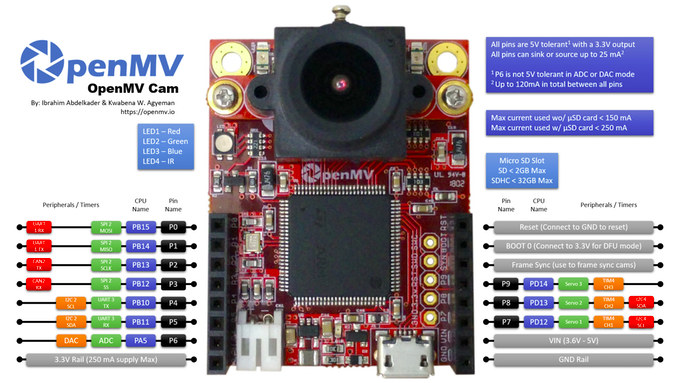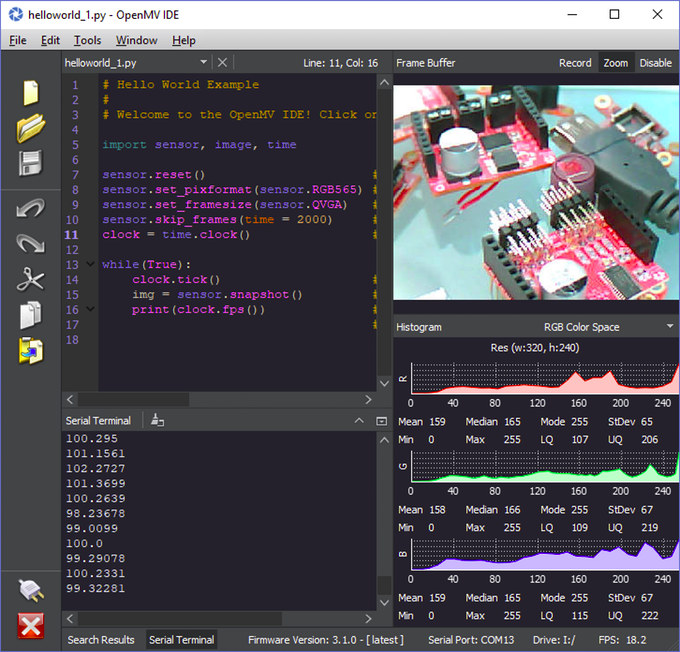OpenMV team has launched an upgrade to their popular OpenMV CAM M7 machine vision camera, with OpenMV CAM H7 replacing the STMicro STM32F7 micro-controller by a more powerful STM32H7 MCU clocked at up to 400 MHz.
Beside having twice the processing power, the new camera board also features removable camera modules for thermal vision and global shutter support.
 OpenMV CAM H7 camera board specifications:
OpenMV CAM H7 camera board specifications:
- MCU – STMicro STM32H743VI Arm Cortex M7 microcontroller @ up to 400 MHz with 1MB RAM, 2MB flash.
- External Storage – micro SD card socket supporting up to 100 Mbps read/write to record videos and store machine vision assets.
- Camera modules
- Omnivision OV7725 image sensor (default) capable of taking 640×480 8-bit Grayscale / 16-bit RGB565 images at 60 FPS when the resolution is above 320×240 and 120 FPS when it is below; 2.8mm lens on a standard M12 lens mount
- Optional Global Shutter camera module to capture high quality grayscale images not affected by motion blur
- Optional FLIR Lepton adapter module for thermal machine vision applications
- USB – Full speed (12 Mbps) micro USB interface with the board appearing as a Virtual COM Port and a USB Flash Drive in your computer
- I/Os
- 1x SPI bus up to 100 Mbps, 1x I2C
- CAN Bus, Asynchronous Serial Bus (TX/RX)
- 12-bit ADC, 12-bit DAC.
- 3x I/O pins for servo control.
- Interrupts and PWM on all I/O pins (10 I/O pins on the board).
- Misc – RGB LED, 2x high power 850nm IR LEDs.
- Power Supply
- 5V via micro USB port
- LiPo battery connector compatible with 3.7V LiPo batteries.
- Dimensions – 45 x 36 mm
- Weight – 19 grams
The camera board can be programmed with MicroPython 3 using OpenMV IDE, but if you prefer C language, the firmware is open source and you can modify it as you wish.
Some of the many applications supported by OpenMV CAM M7/H7 board include Frame Differencing (detect motion in a scene by looking at what’s changed), Color Tracking (up to 16 colors), Marker Tracking (2 or more color tags), Face Detection, Eye Tracking, Optical Flow (to detect translation of what your OpenMV Cam is looking at. For example, to determine how stable a drone is in the air), QR Code Detection/Decoding, Data Matrix Detection/Decoding (2D barcodes), Linear Barcode Decoding, AprilTag Tracking, Line and Circle Detection, image capture, and video recording.
OpenMV CAM H7 also adds support for Multi-Blob Color Tracking at up to 80 FPS, Global Shutter at 80 FPS at VGA/QVGA, 200 FPS at QQVGA, and 400 FPS at QQQVGA, thermal vision support via a FLIR camera module, as well as CNN neural networks via Arm’s CMSIS-NN library.
OpenMV CAM H7 has now launched on Kickstarter with a $50,000 funding goal. Rewards start at $49 for the Basic kit camera board with OV7729 camera module, but depending on your target application(s), you may consider a $99 for the Global shutter kit based on the Basic kit plus the global shutter module, or $329 for the thermal vision pack which includes the FLIR thermal camera module. A $379 pledge would get you an OpenMV CAM H7 board with the three modular camera modules. Shipping adds $15 to the total, and while most rewards are available worldwide, the ones with the FLIR module ships to a more limited number of countries (e.g. no Asian countries). You’ll have to be fairly patient before getting you board as actual shipping is only planned for March 2019.

Jean-Luc started CNX Software in 2010 as a part-time endeavor, before quitting his job as a software engineering manager, and starting to write daily news, and reviews full time later in 2011.
Support CNX Software! Donate via cryptocurrencies, become a Patron on Patreon, or purchase goods on Amazon or Aliexpress






“Optional Global Shutter camera module to capture high quality grayscale images not affected by motion blur”
There’s still going to be motion blur. No getting around that, even with 10,000FPS image-intensifying camera.
What I think they meant was that the Global Shutter avoids the Rolling Shutter motion distortion effects such as Jello.
Why don’t they use the Allwinner V5? Magnitudes more powerful hardware in the same price range.
http://www.lindeni.org/lindenis-v5.html
Also discussed there 🙂 -> https://www.cnx-software.com/2018/08/31/lindenis-v5-allwinner-v5-sbc-4k-smart-linux-camera/
I guess because they want a fully open SoC with good documentation (great documentation if you’re used to chinese leaks) and good reputation (old-world good, again). I.e. where everything is truly under user control.
OpenCam H7 Plus available for pre-order for $80: https://openmv.io/collections/products/products/openmv-cam-h7-plus
Works just like an OpenMV Cam H7 but without any resolutions limits.